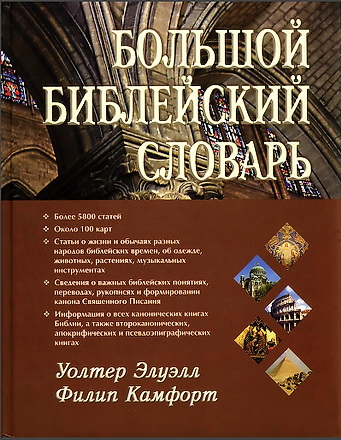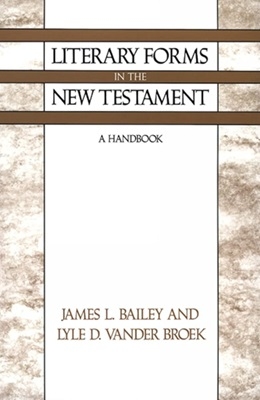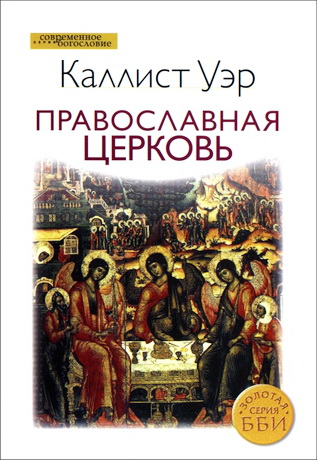
Bailey - Vander Broek - Literary Forms in the New Testament
James L. Bailey, Lyle D. Vander Broek - Literary Forms in the New Testament
Louisville, KY: Westminster/John Knox Press, 1992. – 220 p.
ISBN 0-664-25154-4
The impulse for writing this book comes primarily from our seminary teaching. As teachers of the Bible, we seek to help incoming students practice interpretive procedures that will allow them to grapple responsibly with New Testament texts. One of the exegetical steps that is consistently problematic for our students deals with literary form. Inexperienced interpreters, we have discovered, often exhibit little or no awareness of how a text communicates its message because they do not understand the nature and function of the passage's literary form. We live in a society that has little knowledge of the workings of literary forms, even though there is no such thing as "formless" speech or writing in the contemporary world. When someone greets us with the words "How are you doin'?" we usually respond in a way that is consistent with the form ("Okay" or "Fine"), although such responses may not reflect the true state of our health. The form molds our speech in a powerful way, yet it has become so commonplace that we are not normally conscious of its role in communication. Or when reading a newspaper, we unconsciously discern the differences between the editorial or feature story or obituary and interpret accordingly, yet few people are cognizant of the literary forms of these pieces and how they relate to what is being communicated.
If most people have little awareness of the oral and literary forms used for communicating in the present environment, it is not surprising that entering seminarians often know little or nothing about the specific literary forms that were used in the first-century world and now appear in the New Testament. Of course, this lack of knowledge about ancient forms represents a serious problem for the New Testament interpreter. Although we might be able to intuit the formal characteristics of contemporary literary forms and interpret accordingly, such is hardly possible with forms that are not used in our society. Moreover, even after students become aware of certain New Testament forms, they still might have difficulty in understanding how knowledge of a specific form is helpful in the interpretive process. As teachers interested in cultivating seminarians' sensitivity to New Testament literary forms, we have noted a lack of appropriate resources for the beginning student. While the more common forms confronted, such as Gospel, parable, and letter, are discussed in the introductory literature, many forms that the student learns about in commentaries and monographs are defined only in rather specialized and often hard-to-find articles. More often than not, these scholarly treatments have little to say about the significance of the literary form for the exegetical task engaged in by the seminary student or pastor.
This volume attempts to address these concerns. Each article defines a common New Testament literary form, gives numerous examples, suggests ways in which knowledge of the form is helpful in interpretation, and offers an annotated bibliography for the specific form discussed. There is a decidedly exegetical emphasis throughout. We try to pose and to some extent answer questions the exegete is confronted with as she or he interprets a literary form in preparation for proclamation and teaching. The book's comprehensive nature (over thirty forms are discussed) and its exegetical focus encourage us to hope that it will have an ongoing value as a reference tool for those engaged in biblical interpretation.
* * *
APOCALYPTIC LANGUAGE AND FORMS
Definition of the Forms
According to most definitions, neither the Gospels nor the book of Acts can be classified as an apocalypse, a literary genre represented by the book of Revelation (see Apocalypse). Nonetheless, the Gospels and Acts unquestionably use apocalyptic language wherever they speak about judgment and resurrection or include terms like "the reign of God" and "Son of Man." In the ancient world, apocalyptic speech most often originated when some figure in the religious community became privy to a "revelation" of what God was about to do in the near future and then spoke to that community, calling people to a new vision of the present order in light of God's impending future action. Thus apocalyptic language expresses a religious perspective that views the immediate future as a time when divine saving and judging activity will deliver God's people out of the present evil order into a new order. This transformation, according to the apocalyptic seer, will be cataclysmic and cosmic in scope (see Apocalyptic Language and Forms in the Pauline Tradition section of this volume).
Apocalyptic Language
Clearly, the synoptic Gospels present Jesus as using apocalyptic speech; at the same time, they include only a few passages that hint at his "revelatory experiences" that would account for this way of speaking (see Mark 1:9-11; 9:2-8; Luke 10:17-20; Matt. ll:25-27/Luke 10:21-22). Jesus' apocalyptic language surfaces in his sayings and parables. For example, in Mark 1:15, Jesus announces the imminent arrival of "the reign of God," clearly an apocalyptic symbol: "The time is fulfilled, and the kingdom of God has come near; repent, and believe in the good news" (see also Matt. 10:7; 12:28; Luke 11:20). Or, in Mark 14:62, Jesus responds to the high priest's question about his messianic identity by alluding to an apocalyptic scene in Daniel: "I am; and 'you will see the Son of Man seated at the right hand of the Power,' and 'coming with the clouds of heaven.' " The beatitude is yet another type of Jesus' apocalyptic sayings, as the use of future verbs confirms. The two beatitudes in Luke 6:21 offer specific examples: "Blessed are you who are hungry now, for you will be filled. Blessed are you who weep now, for you will laugh. " Those followers of Jesus who are hungry and in pain in the present age will experience joy and be satisfied by God's action in the new age.
As further illustration of the pervasiveness of apocalyptic motifs in Jesus' speech, all the following parables of Jesus depend on an apocalyptic background for developing their message: Luke 12:13-21; Luke 16:19-31; Matt. 18:23-35; Matt. 20:1-16; Matt. 22:1-10/Luke 14:16-24; Matt. 24:45-51/Luke 12:42-46; Matt. 25:1-13; Matt. 25:14-30/Luke 19:12-27; Matt. 25:31-46. In the material about John the Baptizer, there also appear apocalyptic images: "the wrath to come" (Luke 3:7);
"the ax ... lying at the root of the trees" (Luke 3:9); the Coming One with "winnowing fork ... in his hand" (Luke 3:17); and chaff burning "with unquenchable fire" (Luke 3:17).
Formally, many sayings of Jesus exhibit a "two-part structure in which the first part is related to the present and the second to the future" (Aune 1983, 166). This "present/future polarity reflects the Jewish apocalyptic conception of two ages," according to David Aune. The following examples demonstrate this structure :
For those who want to save their life/will lose it, and those who lose their life for my sake .../will save it. (Mark 8:35)
... whoever does not receive the kingdom of God as a little child/ will never enter it. (Mark 10:15)
... for all who exalt themselves/will be humbled, but all who humble themselves/will be exalted. (Luke 18:14b)
The "present/future" polarity in the sayings of Jesus also functions in an ethical way. Jesus' apocalyptic vision of the future becomes the basis for paraenesis, that is, for his exhorting hearers to think and act in specific ways.
Pronouncements of Holy Law
Some of Jesus' sayings that have the two-part structure also exhibit other formal characteristics. In an important article (66-81), Ernst Käsemann analyzed sayings in Paul and the Gospels that he called "sentences of holy law." Aune (1983, 166-167) summarizes the characteristics of the "holy law" form as follows :
1. The pronouncement is structured in the form of a chiasmus;
2. The same verb is found in both parts of the pronouncement;
3. The second part of the pronouncement deals with the eschatological activity of God and has the verb in the future passive (the passive is frequently a circumlocution for divine activity);
4. The central feature of the pronouncement is the principle of retributive justice (jus talionis);
5. The first part of the pronouncement is introduced by the casuistic legal form "if anyone" or "whoever," whereas the second part is in the style of apodictic divine law.
First Corinthians 3:17 and 14:38 are examples of this form in Paul; Mark 8:38 and Luke 12:8-9 provide examples in the Gospels :
For whoever is ashamed of me and my words
in this evil and sinful generation,
the Son of Man also will be ashamed of him/her,
whenever he comes in the glory of his father
with the holy angels. (Mark 8:38, author's translation)
And I tell you,
everyone who acknowledges me before others,
the Son of Man also will acknowledge before the angels of God;
but whoever denies me before others
will be denied before the angels of God. (Luke 12:8-9)
An analysis of Mark 8:38 illustrates the formal characteristics of the "holy law" in the following manner: (1) the words "whoever" (A) and "of me" (B) in the first line and "Son of Man" (B') and "him/her" (A') in the second line form the chiastic pattern; (2) the verb "ashamed" appears in both the first and second part of the saying; (3) the verb "will be ashamed" in the second part is a future passive form in Greek; (4) the principle of retributive justice, where the penalty fits the offense, is manifested in Jesus' (as the Son of Man) being ashamed of the one who was ashamed of him; (5) the "whoever" is one way to introduce the casuistic form to indicate that this saying applies to anyone who fits the situation described.
Eschatologieal Correlatives
"Eschatological correlative" is another related form that was identified and labeled by Richard Edwards (1960, 9-20). As noted by Edwards: "A correlative construction is one which brings together two items or persons in order to show a reciprocal relationship between them. The standard correlative form would be: As is the case with A, so it is with B" (11). This form occurs five times in Luke and Matthew (Luke ll:30/Matt. 12: 40; Luke 17:24/Matt. 24:27; Luke 17:26/Matt. 24:37; Luke 17:28, 30/Matt. 24:38-39; Matt. 13:40-41), but it never appears in Mark or John. Jesus' saying in Luke 11:30 displays the pattern of the eschatological correlative :
For just as Jonah became a sign to the people of Nineveh, so the Son of Man will be to this generation.
In an eschatological correlative, the first clause begins with the comparative word "just as" (kathōs) or "even as" (hōsper) and contains a verb in past or present tense, whereas the second clause usually begins with the correlative word "so"/"in this way" (houtōs) and includes the future tense "will be" (estai). This form, which resembles the sentence of holy law, always mentions the "Son of Man" in its second clause. Because this form appears frequently in the Septuagint version of the Hebrew prophets, some scholars prefer to label it a "prophetic correlative" (Schmidt, 517-522).
End-times Prophecies
Finally, it should be observed that Mark 13:3-37 is an example of an extended discourse in which Jesus predicts the destruction of the Temple and the events surrounding the end-time (see also Matt. 24:1-36 and Luke 21:5-33). The material of this chapter, which was probably arranged by Mark, presents Jesus' apocalyptic scenario: he predicts the tumultuous events leading up to the end, including the appearance of false messiahs (vs. 6, 21-22), conflicts between nations (vs. 7-8a), earthquakes and famines (v. 8b), and the trials and suffering of the faithful (vs. 9-13). Further, he describes the dissolution of the cosmic order (vs. 24-25) and the appearance of the Son of Man to gather the elect from all parts of the world (vs. 26-27).
But in those days, after that suffering,
the sun will be darkened,
and the moon will not give its light,
and the stars will be falling from heaven,
and the powers in the heavens will be shaken. Then they will see "the Son of Man coming in clouds" with great power and glory. Then he will send out the angels, and gather his elect from the four winds, from the ends of the earth to the ends of heaven. (13:24-27)
This description echoes apocalyptic language in Joel 2:30-31 and Daniel 7:13.
Whether Mark 13 represents a literary genre is a matter of some debate (see Aune 1983, 186). In its present form in Mark, however, it definitely exercises a paraenetic or exhortative function. A close reading reveals a series of present-tense imperative verbs ("beware" in v. 5; "beware" in v. 9; "do not worry beforehand" in v. 11; "be alert" in v. 23; "learn" in v. 28; "beware, keep alert" in v. 33; "keep awake" in v. 35; and "keep awake" in v. 37) that all address the Markan community. Hence Jesus' prolonged discourse is apparently designed to teach the Markan audience about the final days and, of more importance, to call them to constant vigilance in the midst of dismaying and uncertain times. This discourse section, especially with its stress on the glorious coming of the Son of Man, provides the apocalyptic symbols to make sense of the unnerving and threatening events facing the community. Mark 13:9-13, in particular, suggests that the Christians to whom Mark wrote were experiencing harsh repercussions from the catastrophic events surrounding the Romans' destruction of Jerusalem with its Temple in 70 ce.
The Value for Interpretation
Knowledge of apocalyptic language and forms helps the interpreter to recognize their evocative character. Apocalyptic language is language stretched to its limits, evoking images and memories from Israel's past and, above all, as a response to their present loss of meaning, creating a picture of reality that transcends the everyday and historical circumstances of the audience to whom it is directed. In Amos Wilder's terms (153-168), it is language that is "precultural" and "prepersonal," that is, language devoid of the normal human and cultural features.
Moreover, apocalyptic language is richly symbolic, sometimes offering strange and hyperbolic images. It is inappropriate to identify apocalyptic symbols with specific historical or transhistorical referents too easily because this reduces the expressive power of the symbols. It is far more appropriate to approach apocalyptic language as ambiguous and polyvalent, as language that can be interpreted at various levels of meaning, because it seeks to envision reality beyond our imagination. For example, the apocalyptic phrase on the lips of Jesus "the reign of God" is best approached as a polyvalent term that cannot be conceptually explained. As a rich and ambiguous symbol, its use can continue to evoke fresh insights into God's activity vis-à-vis the world.
The interpreter should also consider the nature of the first-century contexts addressed by apocalyptic language. Language becomes hyperbolic in the face of situations of cultural and religious loss and in the face of an actual or perceived chaos, when the continuities and patterns counted on by a community seem to be disrupted or are being destroyed. As noted, it is crucial to understand Jesus' apocalyptic discourse in Mark 13 in terms of its Mar kan context, which was overlaid with anxiety and fear generated by the events surrounding the Roman siege of Jerusalem in 70 c.e.
The more exegetes understand apocalyptic speech in its original context, the more likely they are to detect its misuse in contemporary preaching and teaching. As noted by Paul Hanson: "Genuine apocalypticism arose within a setting of alienation and was never a theological program self-consciously constructed in security and repose" (33). In order to use apocalyptic speech in appropriate ways today, we need awareness both of the characteristics of this daring and unconventional language and of the type of context out of which it emerged.
Selected Bibliography
- Aune, David E. 1983. Prophecy in Early Christianity and the Ancient Mediterranean World. Grand Rapids: Wm. B. Eerdmans. This study includes descriptions of prophetic forms with an apocalyptic focus.
- ————-. 1987. The New Testament in Its Literary Environment, 226-252. Philadelphia: Westminster Press. The final chapter provides a helpful discussion of apocalyptic literature both in Jewish and Greco-Roman circles.
- Edwards, Richard A. 1960. "The Eschatological Correlative as a Gattung in the New Testament." Zeitschrift für die neutestamentlicheWissenschaft 60, 9-20.
- ————-. 1971. The Sign of Jonah in the Theology of the Evangelists andQ, 47-58. Naperville, 111.: Alec R. Allenson.
- Both entries contain the author's discussion of the "eschatological correlative."
- Hanson, Paul D. 1976. "Apocalypticism." Interpreter's Dictionary of the Bible. Suppl. vol. Nashville: Abingdon Press. This entry includes definitions of terms (apocalypse, apocalyptic eschatology, and apocalypticism) and a historical-sociological sketch of apocalypticism.
- Käsemann, Ernst. 1969. "Sentences of Holy Law in the New Testament." New Testament Questions of Today. Translated by W. J. Montague, 66-81. London: SCM Press. This chapter is a translation of the author's influential article published in 1954.
- Schmidt, Daryl. 1977. "The LXX Gattung 'Prophetic Correlative,' " Journal of Biblical Literature 96, 517-522. Schmidt concludes that the correlative form of saying was not a creation of the early church, but was adopted from an earlier prophetic form.
- Wilder, Amos N. 1982. "Apocalyptic Rhetorics." Jesus' Parables and the War of Myths, 153-168. Philadelphia: Fortress Press. This chapter offers an insightful discussion of the rhetorical effect of apocalyptic speech.





Комментарии
Пока нет комментариев. Будьте первым!